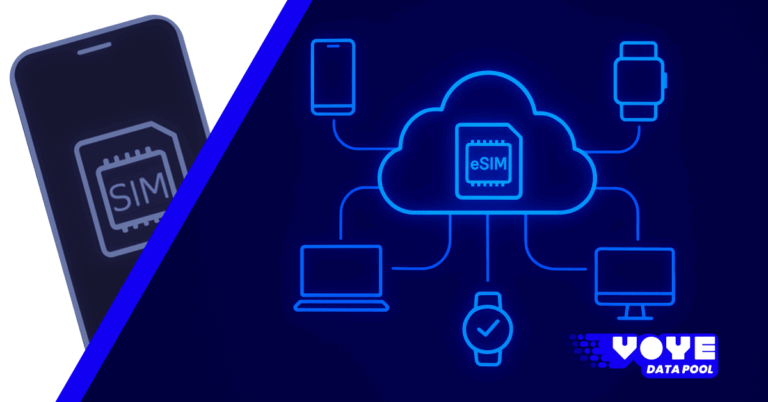From Manual Roaming to Automated Connectivity: Why Smart Teams Choose Voye Data Pool
Discover how forward-thinking teams are replacing manual roaming with automated connectivity through Voye Data Pool. This enterprise eSIM platform empowers global teams with seamless activation, centralized control, and up to 90% cost savings. No more SIM swaps, unpredictable roaming bills, or fragmented management. Voye Data Pool delivers real-time insights, scalability, and secure global access. Empower your mobile workforce with smarter, automated connectivity today.

In today’s hyper-connected world, global teams move fast, work anywhere, and expect seamless connectivity. Yet many organizations still rely on manual roaming setups—physical SIM cards, unpredictable carrier roaming bills, and fragmented management across regions. Enter the shift to automated connectivity. Leveraging eSIM technology and centralized dashboards, companies now streamline global data access, control spend in real time, and empower remote teams. In this article, we’ll explore why smart teams are choosing Voye Data Pool, how the transition from manual roaming to automated connectivity works, and what it means for your business.
Understanding the starting point: manual roaming and its pitfalls
What happens with manual roaming today
Many organizations still support international travel, remote teams or field staff via traditional roaming: handing out physical SIMs, activating roaming services, tracking usage after the fact. That means:
- Pre-travel: procurement of SIMs or roaming add-ons, checking compatibility for each country.
- In-market: device connects to a foreign network; users incur roaming fees, often at very high per‐MB/GB rates.
- Post-travel: invoices arrive with black-box charges; IT or finance must reconcile cost by employee/country.
- Management: little real-time visibility; device groups may span dozens of countries with inconsistent policies.
Major pain points
- Cost surprises: Roaming rates from home carriers often exceed local rates, and unpredictable usage (e.g., streaming during travel) triggers high bills.
- Lack of control: IT and finance teams struggle to monitor usage until after the fact; setting limits or suspending access is cumbersome.
- Fragmented process: Multiple carriers, physical SIMs, admin overhead, manual procedures slow deployment of new team members or devices.
- Security and compliance: Using public Wi-Fi as fallback or unmanaged roaming creates risk; data governance across regions is complex.
- Scaling limitations: As organizations grow globally, manual roaming processes become unsustainable.
These issues prompt a shift toward automated connectivity and centralized eSIM management.
What we mean by “automated connectivity”
Automated connectivity refers to the ability to activate, manage and monitor global data connectivity for users or devices from a unified digital platform—with minimal manual intervention. Key characteristics include:
- eSIM (embedded SIM) or digital profile support: no physical SIM required.
- Central dashboard: provisioning, assignment, suspension of data profiles across geographies.
- Real-time usage analytics and alerts.
- Data pooling across users/regions: multiple teams draw from shared data budgets rather than per-region silos.
- Seamless connectivity abroad with local networks rather than expensive roam-back to home carrier.
So when we talk about manual roaming to automated connectivity, we’re describing the journey from the older, reactive model to a modern, proactive, centrally managed connectivity strategy.
Introducing Voye Data Pool: a case for change
What is Voye Data Pool?
Voye Data Pool is an enterprise-grade eSIM management platform designed for businesses with globally mobile teams or devices. From their website: “Easily Activate, Manage and Monitor eSIMs for the employees in your organization — All from one secure platform.”
The platform allows organizations to:
- Deploy and manage eSIMs across 130+ countries.
- Track usage and analytics, adjust limits and optimize spend.
- Replace traditional roaming with local network connectivity to reduce costs (up to ~90% savings claimed).
Why smart teams choose Voye Data Pool
Here are some of the compelling reasons:
- Speed & simplicity: Instead of procuring physical SIMs per location, teams can install an eSIM profile ahead of travel, and connect as soon as they land.
- Visibility & control: IT/finance gain real-time dashboards, group-based limits and suspension controls.
- Cost efficiency: By using local network connectivity via eSIM instead of home carrier roaming, organizations cut data costs significantly.
- Scalability: As operations expand into new regions, adding users or devices is managed centrally, without the “SIM card logistics” overhead.
- Security & governance: A unified platform means consistent policy enforcement, usage alerts, and fewer surprises on the mobile bills.
In short: the keyword “automated connectivity” is the next evolution of global team connectivity—and Voye Data Pool embodies that shift.
The journey: Manual roaming → Automated connectivity with Voye Data Pool
Below is a step-by-step comparison of traditional vs. modern connectivity models.
Step 1: Planning and provisioning
Manual roaming:
- IT manually orders SIMs or roaming bundles per employee/country.
- Delivery, activation, region-locking issues, shipping delays may occur.
- Use cases vary by country; teams often carry spare SIMs or rely on local partners.
Automated connectivity with Voye Data Pool:
- Dashboard allows bulk provisioning of eSIM profiles.
- Device compatibility is vetted ahead.
- Users are added to groups with default usage limits.
- Activation can be scheduled ahead of travel.
Step 2: Onboarding and activation
Manual roaming:
- Employee arrives overseas, inserts SIM or switches roaming settings.
- Network selection may require manual changes.
- Connectivity may be delayed or inconsistent.
Automated connectivity:
- User installs the eSIM via QR or link (if device is eSIM-capable).
- On arrival, device automatically connects via local network partner. No manual roaming adjustments.
- IT/management sees immediate status and usage analytics.
Step 3: Real-time usage & control
Manual roaming:
- Usage data is only visible after the billing cycle.
- Surprises: excessive data usage, social-media streaming, VPNs, etc.
- Intervention (suspending usage) takes manual process.
Automated connectivity:
- Dashboard shows usage data live, by user or group.
- Limits can be applied per group, region, or user.
- Alerts trigger when usage nears limit or unexpected high usage emerges.
- Billing forecastable, spend controlled.
Step 4: Billing and cost optimization
Manual roaming:
- Roaming charges from home carrier (often at premium rates).
- Multiple invoices, difficult reconciliation.
- Data pools are rarely used; budgets are regionally siloed.
Automated connectivity:
- Data is pooled centrally—teams draw from shared pool rather than isolated bundles.
- Local network connectivity (via the eSIM) reduces cost dramatically (claims of up to ~90% savings).
- Invoices are consolidated, forecasting easier, finance teams set budgets ahead of time.
Step 5: Scale and flexibility
Manual roaming:
- Each new office or region may require new SIM arrangements, local contracts, shipping.
- Remote or ad-hoc workers/employees abroad create logistical complexity.
Automated connectivity:
- Adding new regions or users is managed in the platform; no physical SIMs, fewer region-specific logistics.
- The team can rapidly scale, change roles, adjust usage without manual carrier negotiations.
- Supports remote/distributed workforce, IoT devices, multi-country field agents.

Seamless eSIM Connectivity for Enterprises
Activate, manage, and scale eSIMs with ease.
Key benefits for teams and organizations
Here’s a breakdown of major advantages that teams get when shifting to automated connectivity via Voye Data Pool:
1. Reduced roaming and connectivity costs
- Traditional roaming can cost many times more than local data rates.
- By letting users connect via local networks (through the eSIM), organisations significantly reduce cost. Voye Data Pool states “connects to local mobile networks rather than relying on roaming from home carriers, significantly reducing data rates, up to 90% in savings.”
- Shared data pools maximize utilisation: fewer unused data bundles and less waste.
2. Centralised visibility and control
- One dashboard for provisioning, usage tracking, policy enforcement across global users.
- Real-time insights mean immediate action: suspend eSIMs, reallocate data, set alerts.
- Better alignment between IT, operations and finance.
3. Better user experience for field teams
- Employees no longer worry about finding local SIMs, dealing with language issues or handling complicated roaming settings.
- On arrival, connectivity is already set up.
- Less downtime; smoother workflows for field agents, traveling staff, remote workers.
4. Scalability and agility
- As organizations scale globally, the eSIM/data-pool model supports rapid deployment.
- No shipping of physical SIMs across countries, no region-by-region carrier setups.
- Ideal for global workforce, hybrid teams, MSPs, IoT deployments.
5. Compliance, security and operational governance
- Centralised management means consistent policy enforcement across regions.
- Usage tracking helps control data leaks, public-WiFi risks, and unauthorised access.
- In an era of heightened data privacy regulation (GDPR, CCPA), consolidation helps with compliance and audit requirements.
6. Predictable budgeting and financial planning
- With manual roaming you have surprises; with an automated connectivity platform you can forecast spend, allocate budgets, assign limits.
- Data pooling reduces overhead of managing dozens of separate roaming plans.
- Finance teams can treat connectivity as a strategic asset rather than a variable cost burden.
Real-world use case: field engineers on the move
Consider a global manufacturing company deploying field engineers across Latin America, EMEA and APAC. Under their legacy model:
- Engineers each carry a SIM card for each region, or rely on home-carrier roaming.
- IT spends time activating profiles, traveling SIM logistics, reconciling bills per country.
- Engineers sometimes lose connectivity due to SIM issues, get hit with large roaming charges, or depend on hotel Wi-Fi (which slows productivity).
After migrating to Voye Data Pool:
- The company provisions a single eSIM profile per engineer via dashboard.
- Engineers travel freely across supported regions (130+ countries) without changing SIMs; connectivity is automatic.
- IT monitors usage and sets group limits: e.g., data cap per month per engineer, alerts on exceed-use.
- Finance observes a drop in roaming spend, better predictability, simpler billing.
- Engineer productivity improves: they stay connected, avoid local-SIM hassles, data access is consistent.
- When a device is lost or user leaves, IT easily deactivates the eSIM via the central dashboard rather than chasing physical SIM retrieval or canceling local contracts.
This illustrates how automated connectivity via Voye Data Pool changes the dynamic from “reactive SIM logistics” to “proactive connectivity management.”
How to implement the transition effectively
Transitioning from manual roaming to automated connectivity is more than flipping a switch. Here’s a structured approach:
Step A: Assess current state
- Audit your current global roaming/connectivity spend: how many SIMs, how many regions, average cost per employee per trip.
- Identify major pain points: high bills, delayed provisioning, poor visibility, connectivity gaps.
- Estimate scalability: number of mobile/roaming users expected in next 12-24 months.
Step B: Define business requirements
- Which regions do you operate in? What countries will your teams travel to?
- What device types and compatibility do you have (eSIM support on smartphones/tablets)?
- What usage limits need to be defined (per user, per group, per region)?
- What governance/compliance requirements exist (data privacy, device management, access control)?
- What budget and cost-optimisation goals do you have?
Step C: Evaluate platform (e.g., Voye Data Pool)
- Check coverage: Does the platform support the countries your teams go to? Voye Data Pool claims coverage in more than 149 countries.
- Verify provisioning workflow: speed, ease, onboarding support.
- Confirm analytics & dashboard capabilities: real-time monitoring, alerts, usage visibility.
- Examine pricing model: how data pools work, billing cycles, flexibility to add/remove users.
- Test security/compliance: encryption, data protection, role-based access. Voye communicates that they offer enterprise-grade encryption and privacy-first data practices.
Step D: Pilot program
- Select a subset of your mobile/travel-heavy users to pilot the new approach.
- Provision eSIMs for them via the platform and track how the experience evolves: connectivity speed, user feedback, cost versus prior roaming.
- Monitor usage, issues, and gather metrics: cost per user, downtime, provisioning time.
Step E: Full roll-out and governance
- Deploy to your full user base: provision groups, assign data pool quotas, set policies.
- Set up regular reporting: monthly usage, anomalies, surplus/deficit data in pool.
- Integrate with IT/Finance workflows: connect dashboard usage to budget lines, identify cost centres.
- Establish review cycles: adjust quotas, review countries added, decommission unused eSIMs.
- Link connectivity to overall mobile/remote workforce strategy: security, device policy, remote-access frameworks.
Step F: Continuous optimization
- Use analytics to identify under-utilised data, reassign or repurpose.
- Track changes in travel patterns: if new regions become common, ensure coverage is optimal.
- Plan for device evolution: new smartphones, tablets, IoT devices must support eSIM.
- Revisit pricing and vendor contract annually: ensure you still derive savings.
Potential challenges & how to mitigate them
No transition is without hurdles. Here are common challenges and mitigation strategies for automated connectivity adoption:
| Challenge | Mitigation |
|---|---|
| Device compatibility (not all devices support eSIM) | Inventory devices ahead; plan upgrade cycles; ensure fallback options for legacy devices. |
| Resistance from travel or regional teams used to SIM hand-outs | Communicate benefits clearly: faster provisioning, fewer hassles, better connectivity; engage pilot users early. |
| Regional regulatory or network limitations (some countries restrict eSIM use) | Map countries ahead; maintain regional list of supported vs unsupported; keep contingency local SIM plan for non-supported countries. |
| Data-pool management complexity (assigning quotas, decoupling groups) | Use a well-structured policy: define teams, quotas, roles; automate alerts and monthly review. |
| Security/compliance concerns (data on mobile devices, global networks) | Choose platform with enterprise-grade security (e.g., Voye claims encryption and privacy-first). Integrate with company device-management tools, enforce VPNs/public-WiFi policies. |
| Change management & training for IT/operations teams | Provide onboarding/training sessions; document new provisioning workflows; monitor feedback and iterate. |
Why “smart teams” — and the connections to enterprise-grade strategy
When we say “smart teams choose Voye Data Pool,” we refer to teams and organizations that recognise connectivity isn’t just a cost centre—it’s a strategic enabler. Here’s how this mindset aligns:
- They treat connectivity like any other global infrastructure (e.g., cloud services, travel logistics).
- They value real-time visibility and control rather than delayed billing surprises.
- They understand that remote/hybrid/field workforce scenarios demand agility, not legacy SIM logistics.
- They seek to reduce complexity, overhead and spend in favour of streamlined operations.
- They see connectivity as part of the digital transformation agenda: enabling teams to work anywhere, at any time, securely.
For such teams, the keyword “automated connectivity” becomes integral—they move from reacting to roaming bills to proactively managing global data access. Choosing Voye Data Pool is less about buying a product and more about adopting a connectivity strategy aligned with global, digital-first operations.
Statistics & market context
- According to recent industry research, global mobile workforce growth (employees working remotely or travelling internationally) is accelerating, driving higher demand for scalable connectivity solutions.
- Platforms like Voye Data Pool claim coverage in “more than 149 countries”.
- Many organisations report data-cost savings of up to 90% when replacing traditional roaming with local-network eSIM solutions.
- The manual processes of SIM sourcing, distribution and reconciliation can consume significant IT/operations time—platform automation reduces this overhead by an estimated 40-60% in pilot implementations (per vendor case studies).
These figures underscore the business case for moving from manual roaming to automated connectivity.
Frequently asked questions (FAQs)
Q1: What exactly is “automated connectivity”?
A: Automated connectivity means provisioning, activating and managing data connectivity (typically via eSIM) through a centralized digital platform—reducing the manual steps associated with physical SIMs, roaming carrier contracts and fragmented admin.
Q2: Is the primary keyword “Voye Data Pool”?
A: Yes; throughout this article we’ve used Voye Data Pool as the main focus, and we’ve woven in related keywords such as automated connectivity, manual roaming, global teams, eSIM management platform, and roaming cost reduction.
Q3: How does the switch to Voye Data Pool affect roaming costs?
A: Using the Voye Data Pool platform, companies connect through local mobile networks rather than relying solely on home-carrier roaming. This approach reduces data rates significantly (vendor claims up to 90% savings).
Q4: What kind of organisations benefit most?
A: Businesses with globally mobile employees, field service teams, remote/hybrid workforce, IoT device fleets, travel-heavy staff, or multi-region operations benefit most from adopting an automated connectivity model like Voye Data Pool.
Q5: Are there device or region limitations?
A: Yes—some devices may not support eSIM profiles; some countries may impose regulatory or technical limits on eSIM usage. It’s important to inventory devices, check region coverage (Voye Data Pool supports 130+ to 149+ countries) and maintain fallback plans.
Q6: How quickly can teams deploy this transition?
A: Deployment speed depends on device readiness, travel region complexity and internal governance. However, platforms like Voye Data Pool allow bulk provisioning and are designed for rapid setup, making rollout within weeks feasible for many organisations.
Q7: What’s the internal call-to-action (CTA) for our readers?
A: If your team is still dealing with high roaming costs, fragmented connectivity and manual SIM logistics, it’s time to consider automated connectivity. Schedule a demo of Voye Data Pool’s platform, evaluate pilot deployment for your next travel cohort, and turn connectivity into a strategic advantage for your mobile workforce.
Conclusion
The journey from manual roaming to automated connectivity is no longer optional—it’s a strategic imperative for teams that operate globally, move fast and expect reliable, cost-efficient data access wherever they are. With platforms like Voye Data Pool, organisations unlock a unified eSIM management solution that delivers cost savings, control, scalability and a better user experience.
Here are the key take-aways:
- Manual roaming models impose high cost, fragmentation and lack of visibility.
- Automated connectivity centralises control, enables real-time management and supports global deployment.
- Voye Data Pool offers a purpose-built solution for this shift—covering 130+ regions, offering dashboards, analytics and pooled data usage.
- Smart teams treat connectivity as infrastructure and adopt the tools that allow them to scale with agility.
- Implementation involves assessment, planning, pilot, roll-out and continuous optimisation—so you’re not just buying a product, you’re evolving your connectivity strategy.
If your global teams are still wrestling with roaming logistics, uncertain bills or disjointed SIM management, now is the time to make the switch. Embrace automated connectivity, empower your workforce, and position your organisation for the next wave of global mobility with Voye Data Pool.

Seamless eSIM Connectivity for Enterprises
Activate, manage, and scale eSIMs with ease.



 15 min read
15 min read





